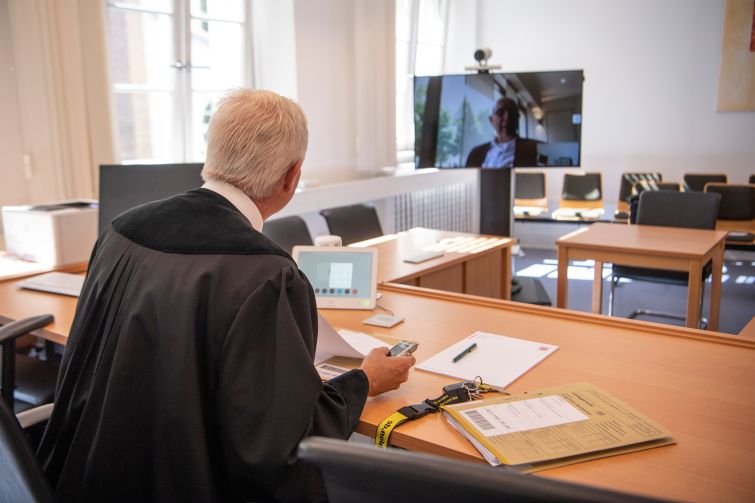Law Firms, Long Rigid About Being in the Office, Warm to Remote Work
Many practices have employees coming in at least three days a week, though
By David M. Levitt June 27, 2023 8:00 am
reprints
The legal profession might never be the same.
The attraction of working from home or a remote location that’s not the office is showing signs of sticking around in the industry in the post-pandemic era. What risks this poses to the landlords who are counting on law firms to fill out office space like they did before the pandemic is an open question.
Data from brokerage Cushman & Wakefield (CWK)’s most recent “Bright Insights” report on the state of the legal industry’s nexus with commercial real estate shows that 58 percent of people who work for the nation’s 100 highest-grossing law firms, according to American Lawyer (AmLaw), and 52 percent of those at all law firms — both attorneys and support — are working outside of the office at least two days a week. David Smith, head of occupier insights for the Americas for C&W and a co-author of the report, said law firms renewing their leases have been taking some 13 percent less office space than they had before.
The big takeaway? That remote work had achieved “relative normalcy” in the profession in the years following COVID.
“We are finding that law firms using hybrid and remote work, on average they’re back in the office more than other sectors, but there is a ton of variance by firms,” Smith said. “Some firms are moving back toward four or five days (in the office) a week, some are wanting their support staff in the office a lot, some are actually encouraging them to be more remote. Overall, we have been seeing law firms getting more dense with their space, using less square footage per attorney.”
This is news landlords may not want to hear. In New York, a study by the real estate graduate schools at Columbia University and New York University found that, assuming consistent levels of working from home, office buildings in that city would be worth close to 60 percent of their 2019 value by 2029. The title of that study was Work From Home and the Office Real Estate Apocalypse. The study predicted that by 2029 U.S. office buildings would collectively lose about $500 billion of value, or 28 percent, if current remote work patterns persist long term.
“Law firms are on the move, taking on less space in upgraded locations,” said Jeannie Tobin, director of market analytics at CoStar (CSGP), a research firm that monitors commercial real estate, in an email. “Some of the larger, more established law firms have made the leap to relocate within the last year after occupying their previous office spaces for decades. There’s a focus on recruitment and retention right now, and with associates needing to learn from partners, it’s still important for people to be in the office. Some law firms are pre-leasing in new construction and downsizing their footprints. According to an industry professional I spoke to, law firms are moving to uniform office sizes to help maximize efficiency, allowing them to upgrade to newer, more amenitized product.”
According to its analysis of CoStar data, C&W found that law firms occupy about 120 million square feet of office in the U.S.
Another brokerage, Savills, found that 90 percent of firms have policies regarding attorney attendance, and on average 55 percent say their attorneys are in at least three days a week. Sixty percent of firms have either adopted or are considering flexible office policies or “hoteling” — meaning desks are unassigned and have to be reserved by an employee.
As was found in an earlier version of “Bright Insights,” law firms are getting more successful, revenue is rising, and there is a link between smart lawyering and client (read: corporate) satisfaction. Among AmLaw 100 firms, gross revenue was up annually in 2022 some 2.7 percent, but revenue per lawyer and profits per equity partner were both down slightly year-over-year. Rising interest rates and expectations of a slowing economy have reduced mergers and acquisitions activity, which tends to swell law firm coffers.
The study found that by 2028 square footage per attorney should fall to 472 square feet, a 5.7 percent decrease. For AmLaw 100 firms, it should be 461 square feet per attorney in five years.
Law firms also can be counted on to spend a large percentage of their overall budgets on real estate. Across all law firms, 10.5 percent of their budgets is devoted to real estate; for firms larger than 1,000 attorneys, the share is 11.8 percent.
One brand-new tower that could be affected is One Manhattan West, a Brookfield (BN)-built, 2 million square foot skyscraper in Manhattan’s Hudson Yards area. In 2020, Skadden Arps Slate Meagher & Flom, recently ranked by Vault.com as the nation’s third-largest law firm, moved there after leasing 550,000 square feet in the tower. According to CoStar data, Skadden ranked fifth in the country in square footage, with 1.3 million square feet.
Calls and emails to Skadden were not returned, but according to a Bloomberg Law story dated May 25, the firm requires its lawyers to work in-person from the office four days a week. “Our modified hybrid work model will harness the best aspects of remote working while fueling innovation,” the story quotes the firm as saying.
An email to Brookfield elicited the following statement: “One Manhattan West is nearly fully leased, and demand for the space at Two Manhattan West (its sister building, nearly complete) is very strong.” The company had no further comment, except to say it would not respond to questions pertaining to an individual tenant.
CoStar reported that Boston Properties (BXP), the nation’s largest publicly traded real estate investment trust dealing in office ownership, had the largest concentration of offices rented to law firms, followed by the Irvine Company, CommonWealth Partners and Brookfield.
According to Boston Properties’ first-quarter supplemental report, dated March 31, its largest tenants include the law firms Kirkland & Ellis (No. 7 with 1.46 percent of its annualized rental obligations), Ropes & Gray (No. 8, 1.43 percent), Arnold & Porter Kaye Scholer (No. 11, 1.15 percent) and Weil Gotshal & Manges (No. 12, 1.11 percent). According to a June 7 story by Benzinga.com, a business website, about 19 percent of its rent is paid by law firms, the second-most industry behind only technology and media companies, at 21 percent.
Calls and emails to Boston Properties were not returned.
Pay no mind to work-from-home/remote work’s impact on law firms, says Alexander Goldfarb, a Piper Sandler REIT analyst who covers Boston Properties. To Goldfarb, it’s a relatively minor trend compared to major technology-related changes that have already affected that industry, such as the reduction of law libraries to computer software, thus reducing the need for firms to have libraries taking up a lot of space.
Plus, several law firms are signing new major leases, such as Holland & Knight, which renewed on 121,000 square feet on its longtime Miami home; Crowell & Moring inking 199,000 square feet to anchor a building to be built in Washington, D.C.; and Japanese law firm Mori Hamada & Matsumoto signing for 5,700 square feet at 360 Madison Avenue in New York City.
“This is far less of a threat than what happened over a decade ago,” Goldfarb said. “No one is trying to get to five days a week, maybe a few companies. Everyone wants their people back at least three days a week. But, if you think about the way law firms and any other office tenant was working before, no one was ever in five days a week. You had people on the road, you had people on vacation, you had people out for personal time or sick time. Maybe they were going to court, maybe they were meeting at the counsel on the other side of the deal.”



